LB5230 - Supply Chain Dynamics: Priceline Group Report Analysis
VerifiedAdded on 2023/01/05
|11
|3076
|65
Report
AI Summary
This report provides an overview of Priceline Group's supply chain management, exploring its evolution within the tourism industry and its adaptation to technological advancements. The report examines the company's reliance on Global Distribution Systems (GDS) and its interactions with airlines, travel agencies, and end-users. It highlights the role of the International Air Transport Association (IATA) and its Billing and Settlement Plan (BSP) in facilitating airline distribution and financial control. The analysis further delves into Priceline's customer-centric approach, the impact of online booking platforms, and the importance of adaptability and sustainability within its value chain. The report also touches upon the challenges and opportunities in reducing distribution costs and the potential impact of new technologies like IATA's New Distribution Capabilities (NDC) on the future of the travel industry.

Running header: Supply chain management 1
Topic:
Student name:
Institution name:
Topic:
Student name:
Institution name:
Paraphrase This Document
Need a fresh take? Get an instant paraphrase of this document with our AI Paraphraser

Running header: Supply chain management 2
The overview of Priceline Group Company
Introduction
The tourism industry has been confronted with intriguing trends and developments for
some aircraft and their intermediaries. This can give the impression that "dispersed" traffic is
beginning to resemble a "networked business", with crusades, offers and advertising channels.
CSAs have long been at the forefront of the road traffic sector (Allden, et al., 2018). At the same
time, further progress has been made in implementing major improvements in the structure of
traffic activities, notably in the division of positions and administration. In order to circumvent
the GDS and stay away from high loads, many aircraft simply disperse flights on their platforms
(Arantes, et al., 2015).
Priceline company overview
Priceline carriers have closed their own ticket offices in many areas of activity. By
attracting customers, it has gradually relied on technologically advanced media. On the other
hand, it can benefit from a customer-oriented administration, where customers can communicate
with the operator through a service-oriented call (Barbara , 2009). This makes it easier for
individual customers to buy tickets online. In addition, significant progress has also been made in
terms of evaluation and inventory to help travel professionals and end users in locations with
different added value.
When booking online, travelers can make their own reservations and pay for their
calendars by credit card or check. In general, customers will receive an e-ticket confirmation
with a unique identification code within 24 hours of ticket purchase (Chavez, et al., 2012). They
can also register online and print their tickets. In addition, they can store their tickets on mobile
The overview of Priceline Group Company
Introduction
The tourism industry has been confronted with intriguing trends and developments for
some aircraft and their intermediaries. This can give the impression that "dispersed" traffic is
beginning to resemble a "networked business", with crusades, offers and advertising channels.
CSAs have long been at the forefront of the road traffic sector (Allden, et al., 2018). At the same
time, further progress has been made in implementing major improvements in the structure of
traffic activities, notably in the division of positions and administration. In order to circumvent
the GDS and stay away from high loads, many aircraft simply disperse flights on their platforms
(Arantes, et al., 2015).
Priceline company overview
Priceline carriers have closed their own ticket offices in many areas of activity. By
attracting customers, it has gradually relied on technologically advanced media. On the other
hand, it can benefit from a customer-oriented administration, where customers can communicate
with the operator through a service-oriented call (Barbara , 2009). This makes it easier for
individual customers to buy tickets online. In addition, significant progress has also been made in
terms of evaluation and inventory to help travel professionals and end users in locations with
different added value.
When booking online, travelers can make their own reservations and pay for their
calendars by credit card or check. In general, customers will receive an e-ticket confirmation
with a unique identification code within 24 hours of ticket purchase (Chavez, et al., 2012). They
can also register online and print their tickets. In addition, they can store their tickets on mobile

Running header: Supply chain management 3
phones or advanced mobile phones to ensure easy access to the security system and when
loading the plane. Travelers should ensure that the entire scanner label is clearly displayed on the
screen of their mobile phone, especially when they cross the security zones of the terminal
(Gibson, et al., 2016).
Supply chain logistics/management forms the source for customers
The improvement of Priceline's logistics allowed the regular development of the
administrations and the search for the capacity of companies in the travel sector. The Chain
system developed by the company allows the exchange of robots between organizations
specialized in movement (for most aircraft organizations, hostels and car rental companies) and
between movement agencies. Priceline has typically relied on GDSs for administrations, items
and fees to allow end users to travel to administrations (Guest & Shawnee, 2009). The GDSs
have established useful links to travel records, fees and dates that summarize travel documents
and records on all pages. Current GDSs typically allow customers to book accommodations, car
rentals, travel tickets and various exercises and visits. In addition, they provide access to train
and traffic bookings in certain industries, although they are not continuously included in the
basic structure. For example, Priceline has created new GDS articles for specialized markets,
including the minimal competitive efforts of airlines, small and medium-sized residential and
provincial aircraft (Hashemzadeh, et al., 2014).
The Priceline Group's main customers are travel specialists (both on the web and in the
office). These agents continuously book a place on the GDSs. If, for example, planes and travel
agencies require a reservation from a specialized office, the GDSs transmit their requests to the
individual CRSs (Jay , 2012). This allows them to book flights, accommodation, exercises and
administration that are legally connected to the merchants that are part of the GDS systems.
phones or advanced mobile phones to ensure easy access to the security system and when
loading the plane. Travelers should ensure that the entire scanner label is clearly displayed on the
screen of their mobile phone, especially when they cross the security zones of the terminal
(Gibson, et al., 2016).
Supply chain logistics/management forms the source for customers
The improvement of Priceline's logistics allowed the regular development of the
administrations and the search for the capacity of companies in the travel sector. The Chain
system developed by the company allows the exchange of robots between organizations
specialized in movement (for most aircraft organizations, hostels and car rental companies) and
between movement agencies. Priceline has typically relied on GDSs for administrations, items
and fees to allow end users to travel to administrations (Guest & Shawnee, 2009). The GDSs
have established useful links to travel records, fees and dates that summarize travel documents
and records on all pages. Current GDSs typically allow customers to book accommodations, car
rentals, travel tickets and various exercises and visits. In addition, they provide access to train
and traffic bookings in certain industries, although they are not continuously included in the
basic structure. For example, Priceline has created new GDS articles for specialized markets,
including the minimal competitive efforts of airlines, small and medium-sized residential and
provincial aircraft (Hashemzadeh, et al., 2014).
The Priceline Group's main customers are travel specialists (both on the web and in the
office). These agents continuously book a place on the GDSs. If, for example, planes and travel
agencies require a reservation from a specialized office, the GDSs transmit their requests to the
individual CRSs (Jay , 2012). This allows them to book flights, accommodation, exercises and
administration that are legally connected to the merchants that are part of the GDS systems.
⊘ This is a preview!⊘
Do you want full access?
Subscribe today to unlock all pages.

Trusted by 1+ million students worldwide
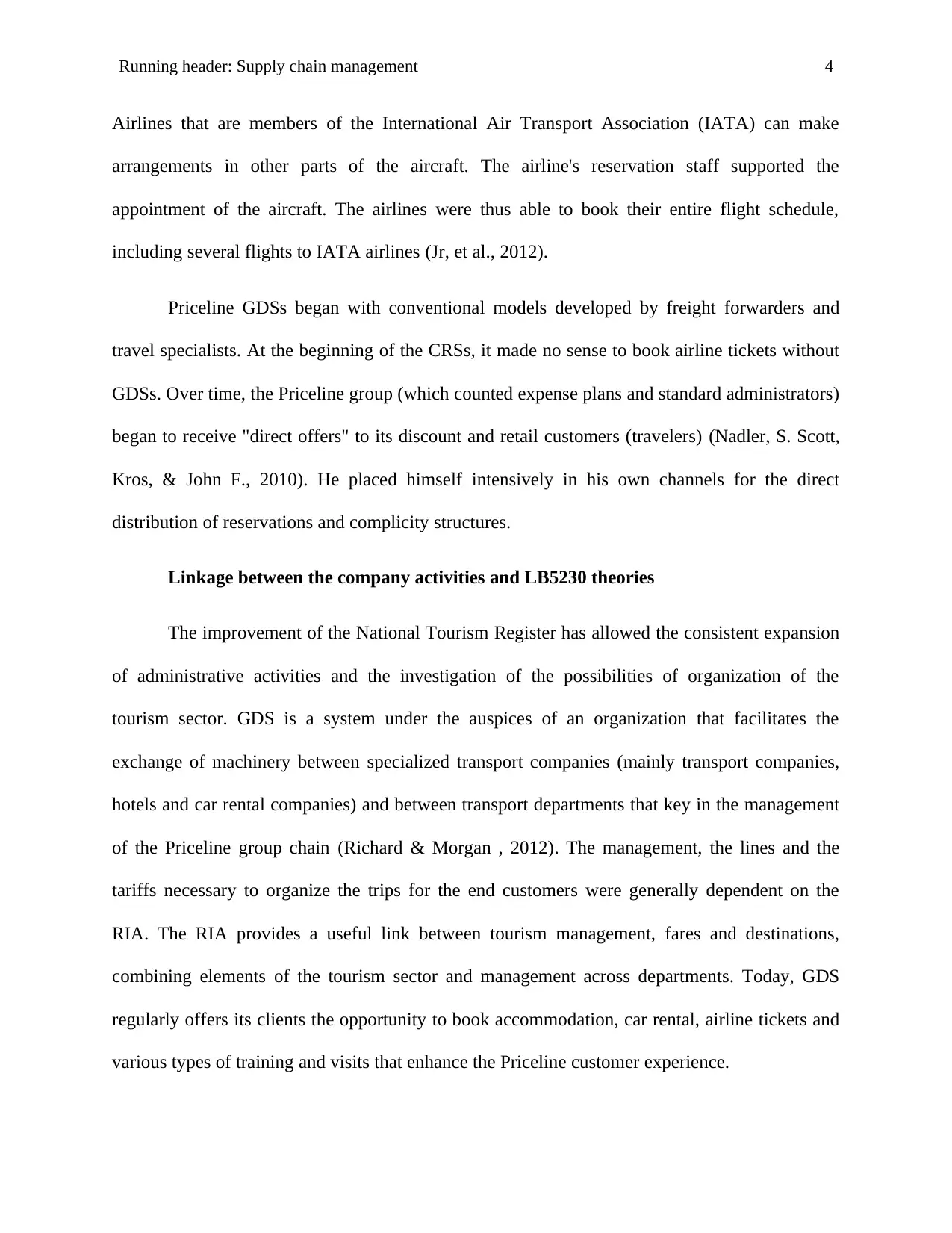
Running header: Supply chain management 4
Airlines that are members of the International Air Transport Association (IATA) can make
arrangements in other parts of the aircraft. The airline's reservation staff supported the
appointment of the aircraft. The airlines were thus able to book their entire flight schedule,
including several flights to IATA airlines (Jr, et al., 2012).
Priceline GDSs began with conventional models developed by freight forwarders and
travel specialists. At the beginning of the CRSs, it made no sense to book airline tickets without
GDSs. Over time, the Priceline group (which counted expense plans and standard administrators)
began to receive "direct offers" to its discount and retail customers (travelers) (Nadler, S. Scott,
Kros, & John F., 2010). He placed himself intensively in his own channels for the direct
distribution of reservations and complicity structures.
Linkage between the company activities and LB5230 theories
The improvement of the National Tourism Register has allowed the consistent expansion
of administrative activities and the investigation of the possibilities of organization of the
tourism sector. GDS is a system under the auspices of an organization that facilitates the
exchange of machinery between specialized transport companies (mainly transport companies,
hotels and car rental companies) and between transport departments that key in the management
of the Priceline group chain (Richard & Morgan , 2012). The management, the lines and the
tariffs necessary to organize the trips for the end customers were generally dependent on the
RIA. The RIA provides a useful link between tourism management, fares and destinations,
combining elements of the tourism sector and management across departments. Today, GDS
regularly offers its clients the opportunity to book accommodation, car rental, airline tickets and
various types of training and visits that enhance the Priceline customer experience.
Airlines that are members of the International Air Transport Association (IATA) can make
arrangements in other parts of the aircraft. The airline's reservation staff supported the
appointment of the aircraft. The airlines were thus able to book their entire flight schedule,
including several flights to IATA airlines (Jr, et al., 2012).
Priceline GDSs began with conventional models developed by freight forwarders and
travel specialists. At the beginning of the CRSs, it made no sense to book airline tickets without
GDSs. Over time, the Priceline group (which counted expense plans and standard administrators)
began to receive "direct offers" to its discount and retail customers (travelers) (Nadler, S. Scott,
Kros, & John F., 2010). He placed himself intensively in his own channels for the direct
distribution of reservations and complicity structures.
Linkage between the company activities and LB5230 theories
The improvement of the National Tourism Register has allowed the consistent expansion
of administrative activities and the investigation of the possibilities of organization of the
tourism sector. GDS is a system under the auspices of an organization that facilitates the
exchange of machinery between specialized transport companies (mainly transport companies,
hotels and car rental companies) and between transport departments that key in the management
of the Priceline group chain (Richard & Morgan , 2012). The management, the lines and the
tariffs necessary to organize the trips for the end customers were generally dependent on the
RIA. The RIA provides a useful link between tourism management, fares and destinations,
combining elements of the tourism sector and management across departments. Today, GDS
regularly offers its clients the opportunity to book accommodation, car rental, airline tickets and
various types of training and visits that enhance the Priceline customer experience.
Paraphrase This Document
Need a fresh take? Get an instant paraphrase of this document with our AI Paraphraser
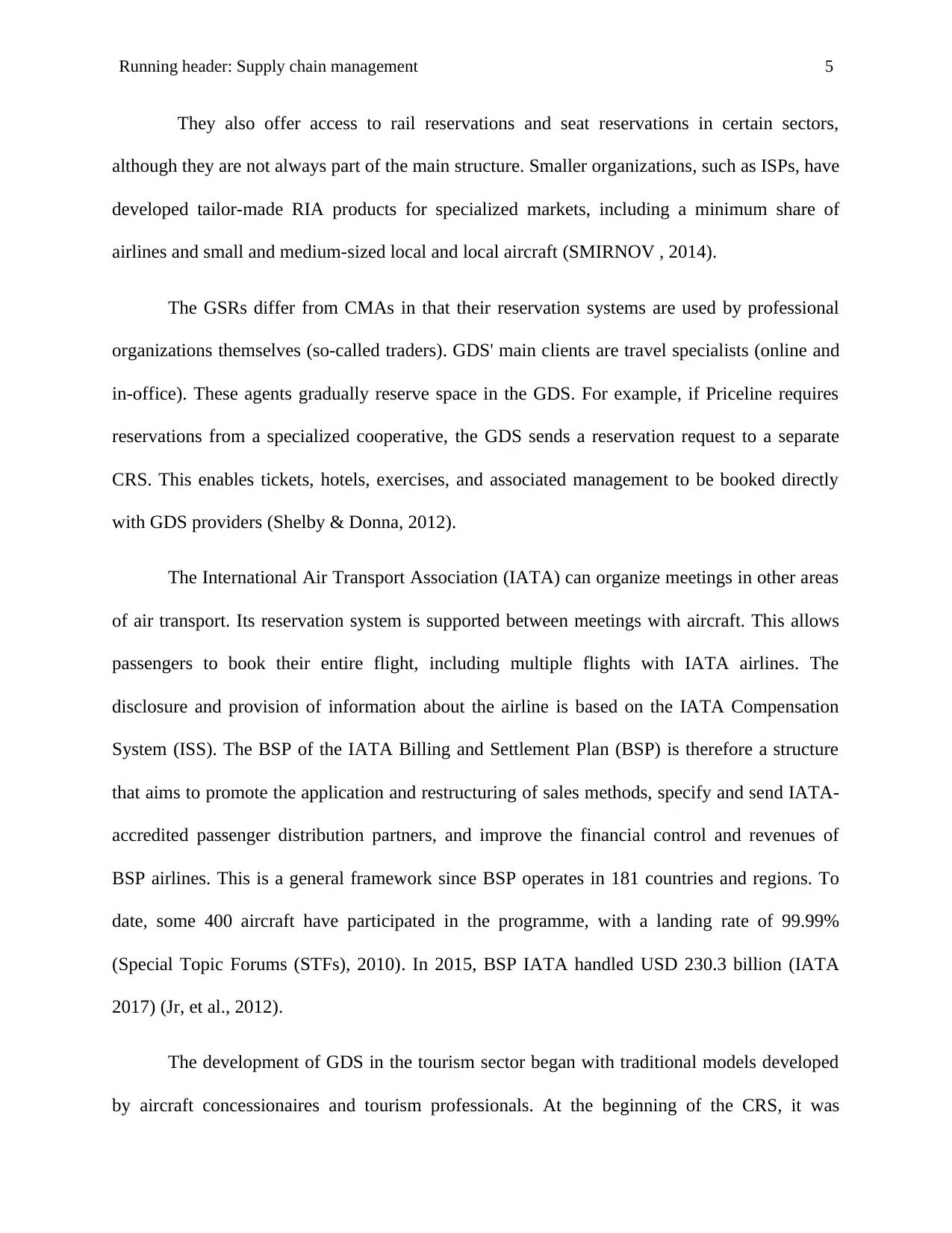
Running header: Supply chain management 5
They also offer access to rail reservations and seat reservations in certain sectors,
although they are not always part of the main structure. Smaller organizations, such as ISPs, have
developed tailor-made RIA products for specialized markets, including a minimum share of
airlines and small and medium-sized local and local aircraft (SMIRNOV , 2014).
The GSRs differ from CMAs in that their reservation systems are used by professional
organizations themselves (so-called traders). GDS' main clients are travel specialists (online and
in-office). These agents gradually reserve space in the GDS. For example, if Priceline requires
reservations from a specialized cooperative, the GDS sends a reservation request to a separate
CRS. This enables tickets, hotels, exercises, and associated management to be booked directly
with GDS providers (Shelby & Donna, 2012).
The International Air Transport Association (IATA) can organize meetings in other areas
of air transport. Its reservation system is supported between meetings with aircraft. This allows
passengers to book their entire flight, including multiple flights with IATA airlines. The
disclosure and provision of information about the airline is based on the IATA Compensation
System (ISS). The BSP of the IATA Billing and Settlement Plan (BSP) is therefore a structure
that aims to promote the application and restructuring of sales methods, specify and send IATA-
accredited passenger distribution partners, and improve the financial control and revenues of
BSP airlines. This is a general framework since BSP operates in 181 countries and regions. To
date, some 400 aircraft have participated in the programme, with a landing rate of 99.99%
(Special Topic Forums (STFs), 2010). In 2015, BSP IATA handled USD 230.3 billion (IATA
2017) (Jr, et al., 2012).
The development of GDS in the tourism sector began with traditional models developed
by aircraft concessionaires and tourism professionals. At the beginning of the CRS, it was
They also offer access to rail reservations and seat reservations in certain sectors,
although they are not always part of the main structure. Smaller organizations, such as ISPs, have
developed tailor-made RIA products for specialized markets, including a minimum share of
airlines and small and medium-sized local and local aircraft (SMIRNOV , 2014).
The GSRs differ from CMAs in that their reservation systems are used by professional
organizations themselves (so-called traders). GDS' main clients are travel specialists (online and
in-office). These agents gradually reserve space in the GDS. For example, if Priceline requires
reservations from a specialized cooperative, the GDS sends a reservation request to a separate
CRS. This enables tickets, hotels, exercises, and associated management to be booked directly
with GDS providers (Shelby & Donna, 2012).
The International Air Transport Association (IATA) can organize meetings in other areas
of air transport. Its reservation system is supported between meetings with aircraft. This allows
passengers to book their entire flight, including multiple flights with IATA airlines. The
disclosure and provision of information about the airline is based on the IATA Compensation
System (ISS). The BSP of the IATA Billing and Settlement Plan (BSP) is therefore a structure
that aims to promote the application and restructuring of sales methods, specify and send IATA-
accredited passenger distribution partners, and improve the financial control and revenues of
BSP airlines. This is a general framework since BSP operates in 181 countries and regions. To
date, some 400 aircraft have participated in the programme, with a landing rate of 99.99%
(Special Topic Forums (STFs), 2010). In 2015, BSP IATA handled USD 230.3 billion (IATA
2017) (Jr, et al., 2012).
The development of GDS in the tourism sector began with traditional models developed
by aircraft concessionaires and tourism professionals. At the beginning of the CRS, it was
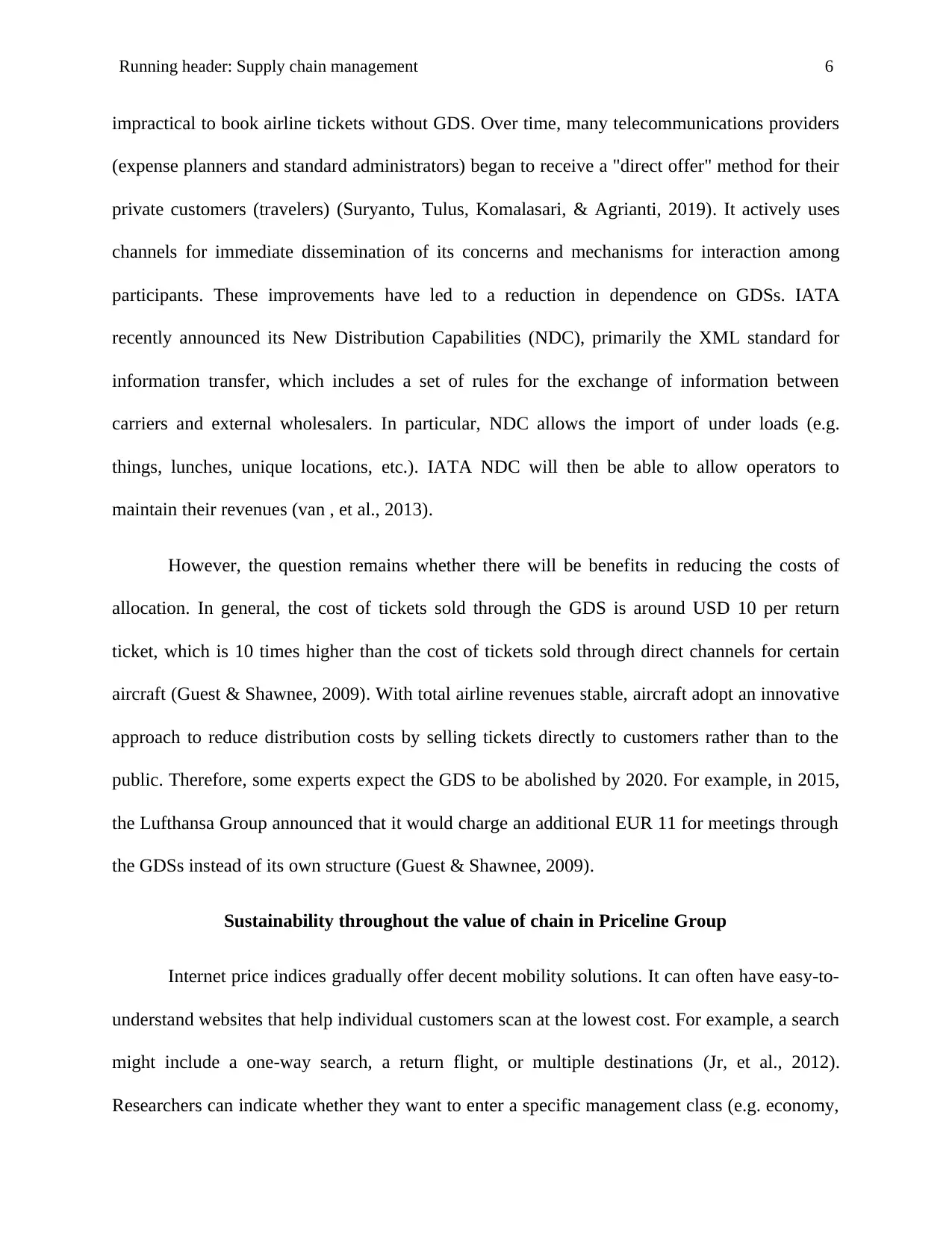
Running header: Supply chain management 6
impractical to book airline tickets without GDS. Over time, many telecommunications providers
(expense planners and standard administrators) began to receive a "direct offer" method for their
private customers (travelers) (Suryanto, Tulus, Komalasari, & Agrianti, 2019). It actively uses
channels for immediate dissemination of its concerns and mechanisms for interaction among
participants. These improvements have led to a reduction in dependence on GDSs. IATA
recently announced its New Distribution Capabilities (NDC), primarily the XML standard for
information transfer, which includes a set of rules for the exchange of information between
carriers and external wholesalers. In particular, NDC allows the import of under loads (e.g.
things, lunches, unique locations, etc.). IATA NDC will then be able to allow operators to
maintain their revenues (van , et al., 2013).
However, the question remains whether there will be benefits in reducing the costs of
allocation. In general, the cost of tickets sold through the GDS is around USD 10 per return
ticket, which is 10 times higher than the cost of tickets sold through direct channels for certain
aircraft (Guest & Shawnee, 2009). With total airline revenues stable, aircraft adopt an innovative
approach to reduce distribution costs by selling tickets directly to customers rather than to the
public. Therefore, some experts expect the GDS to be abolished by 2020. For example, in 2015,
the Lufthansa Group announced that it would charge an additional EUR 11 for meetings through
the GDSs instead of its own structure (Guest & Shawnee, 2009).
Sustainability throughout the value of chain in Priceline Group
Internet price indices gradually offer decent mobility solutions. It can often have easy-to-
understand websites that help individual customers scan at the lowest cost. For example, a search
might include a one-way search, a return flight, or multiple destinations (Jr, et al., 2012).
Researchers can indicate whether they want to enter a specific management class (e.g. economy,
impractical to book airline tickets without GDS. Over time, many telecommunications providers
(expense planners and standard administrators) began to receive a "direct offer" method for their
private customers (travelers) (Suryanto, Tulus, Komalasari, & Agrianti, 2019). It actively uses
channels for immediate dissemination of its concerns and mechanisms for interaction among
participants. These improvements have led to a reduction in dependence on GDSs. IATA
recently announced its New Distribution Capabilities (NDC), primarily the XML standard for
information transfer, which includes a set of rules for the exchange of information between
carriers and external wholesalers. In particular, NDC allows the import of under loads (e.g.
things, lunches, unique locations, etc.). IATA NDC will then be able to allow operators to
maintain their revenues (van , et al., 2013).
However, the question remains whether there will be benefits in reducing the costs of
allocation. In general, the cost of tickets sold through the GDS is around USD 10 per return
ticket, which is 10 times higher than the cost of tickets sold through direct channels for certain
aircraft (Guest & Shawnee, 2009). With total airline revenues stable, aircraft adopt an innovative
approach to reduce distribution costs by selling tickets directly to customers rather than to the
public. Therefore, some experts expect the GDS to be abolished by 2020. For example, in 2015,
the Lufthansa Group announced that it would charge an additional EUR 11 for meetings through
the GDSs instead of its own structure (Guest & Shawnee, 2009).
Sustainability throughout the value of chain in Priceline Group
Internet price indices gradually offer decent mobility solutions. It can often have easy-to-
understand websites that help individual customers scan at the lowest cost. For example, a search
might include a one-way search, a return flight, or multiple destinations (Jr, et al., 2012).
Researchers can indicate whether they want to enter a specific management class (e.g. economy,
⊘ This is a preview!⊘
Do you want full access?
Subscribe today to unlock all pages.

Trusted by 1+ million students worldwide
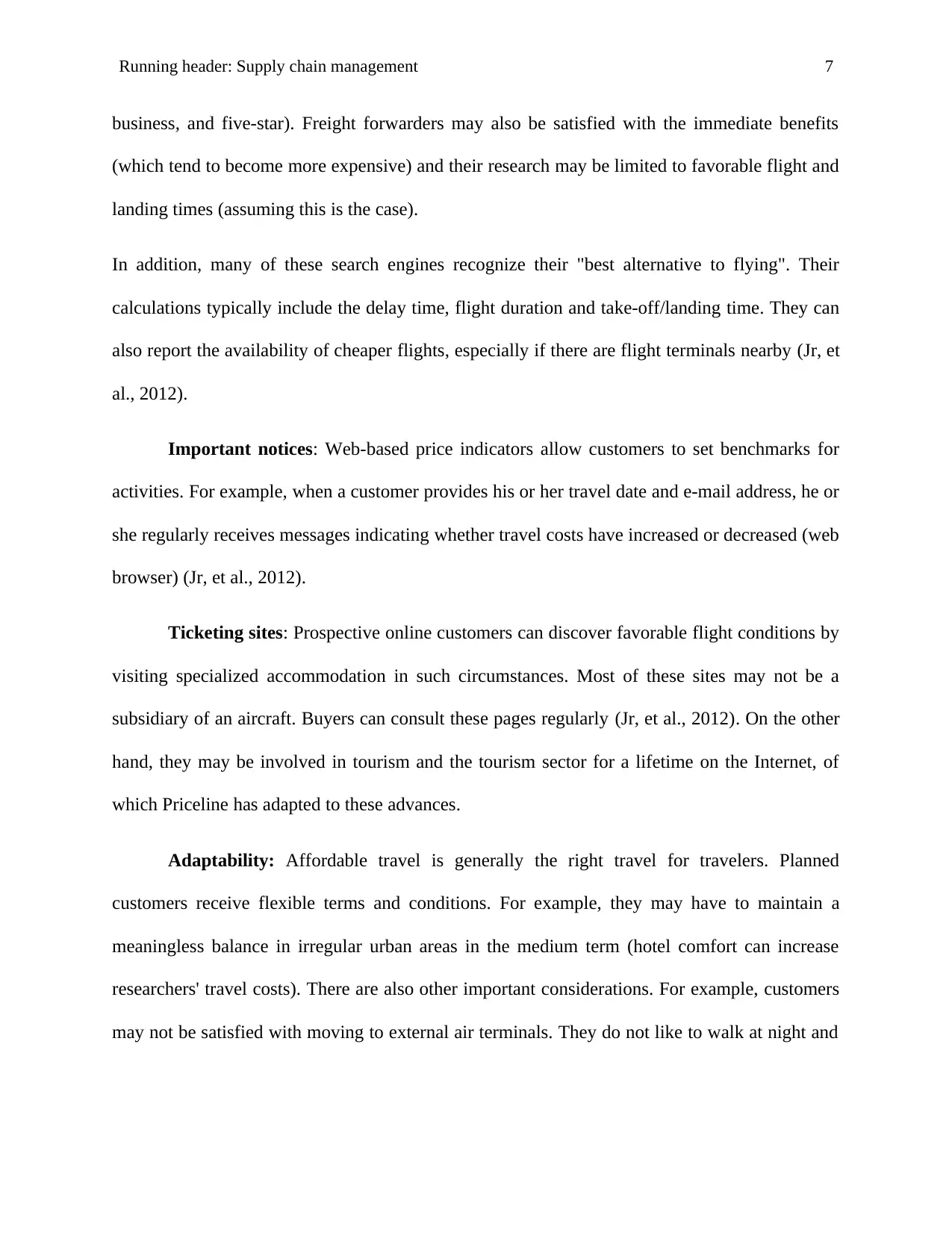
Running header: Supply chain management 7
business, and five-star). Freight forwarders may also be satisfied with the immediate benefits
(which tend to become more expensive) and their research may be limited to favorable flight and
landing times (assuming this is the case).
In addition, many of these search engines recognize their "best alternative to flying". Their
calculations typically include the delay time, flight duration and take-off/landing time. They can
also report the availability of cheaper flights, especially if there are flight terminals nearby (Jr, et
al., 2012).
Important notices: Web-based price indicators allow customers to set benchmarks for
activities. For example, when a customer provides his or her travel date and e-mail address, he or
she regularly receives messages indicating whether travel costs have increased or decreased (web
browser) (Jr, et al., 2012).
Ticketing sites: Prospective online customers can discover favorable flight conditions by
visiting specialized accommodation in such circumstances. Most of these sites may not be a
subsidiary of an aircraft. Buyers can consult these pages regularly (Jr, et al., 2012). On the other
hand, they may be involved in tourism and the tourism sector for a lifetime on the Internet, of
which Priceline has adapted to these advances.
Adaptability: Affordable travel is generally the right travel for travelers. Planned
customers receive flexible terms and conditions. For example, they may have to maintain a
meaningless balance in irregular urban areas in the medium term (hotel comfort can increase
researchers' travel costs). There are also other important considerations. For example, customers
may not be satisfied with moving to external air terminals. They do not like to walk at night and
business, and five-star). Freight forwarders may also be satisfied with the immediate benefits
(which tend to become more expensive) and their research may be limited to favorable flight and
landing times (assuming this is the case).
In addition, many of these search engines recognize their "best alternative to flying". Their
calculations typically include the delay time, flight duration and take-off/landing time. They can
also report the availability of cheaper flights, especially if there are flight terminals nearby (Jr, et
al., 2012).
Important notices: Web-based price indicators allow customers to set benchmarks for
activities. For example, when a customer provides his or her travel date and e-mail address, he or
she regularly receives messages indicating whether travel costs have increased or decreased (web
browser) (Jr, et al., 2012).
Ticketing sites: Prospective online customers can discover favorable flight conditions by
visiting specialized accommodation in such circumstances. Most of these sites may not be a
subsidiary of an aircraft. Buyers can consult these pages regularly (Jr, et al., 2012). On the other
hand, they may be involved in tourism and the tourism sector for a lifetime on the Internet, of
which Priceline has adapted to these advances.
Adaptability: Affordable travel is generally the right travel for travelers. Planned
customers receive flexible terms and conditions. For example, they may have to maintain a
meaningless balance in irregular urban areas in the medium term (hotel comfort can increase
researchers' travel costs). There are also other important considerations. For example, customers
may not be satisfied with moving to external air terminals. They do not like to walk at night and
Paraphrase This Document
Need a fresh take? Get an instant paraphrase of this document with our AI Paraphraser
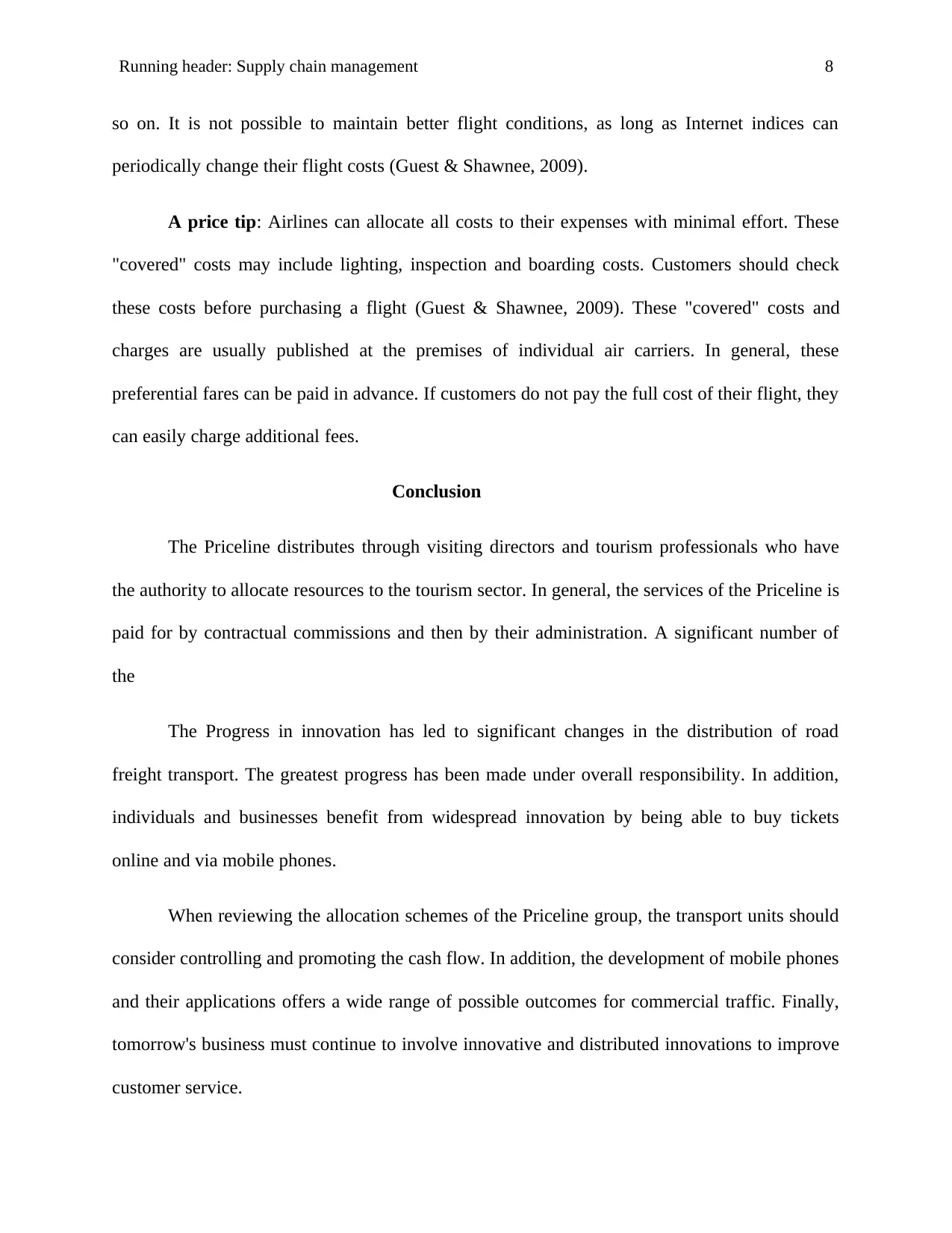
Running header: Supply chain management 8
so on. It is not possible to maintain better flight conditions, as long as Internet indices can
periodically change their flight costs (Guest & Shawnee, 2009).
A price tip: Airlines can allocate all costs to their expenses with minimal effort. These
"covered" costs may include lighting, inspection and boarding costs. Customers should check
these costs before purchasing a flight (Guest & Shawnee, 2009). These "covered" costs and
charges are usually published at the premises of individual air carriers. In general, these
preferential fares can be paid in advance. If customers do not pay the full cost of their flight, they
can easily charge additional fees.
Conclusion
The Priceline distributes through visiting directors and tourism professionals who have
the authority to allocate resources to the tourism sector. In general, the services of the Priceline is
paid for by contractual commissions and then by their administration. A significant number of
the
The Progress in innovation has led to significant changes in the distribution of road
freight transport. The greatest progress has been made under overall responsibility. In addition,
individuals and businesses benefit from widespread innovation by being able to buy tickets
online and via mobile phones.
When reviewing the allocation schemes of the Priceline group, the transport units should
consider controlling and promoting the cash flow. In addition, the development of mobile phones
and their applications offers a wide range of possible outcomes for commercial traffic. Finally,
tomorrow's business must continue to involve innovative and distributed innovations to improve
customer service.
so on. It is not possible to maintain better flight conditions, as long as Internet indices can
periodically change their flight costs (Guest & Shawnee, 2009).
A price tip: Airlines can allocate all costs to their expenses with minimal effort. These
"covered" costs may include lighting, inspection and boarding costs. Customers should check
these costs before purchasing a flight (Guest & Shawnee, 2009). These "covered" costs and
charges are usually published at the premises of individual air carriers. In general, these
preferential fares can be paid in advance. If customers do not pay the full cost of their flight, they
can easily charge additional fees.
Conclusion
The Priceline distributes through visiting directors and tourism professionals who have
the authority to allocate resources to the tourism sector. In general, the services of the Priceline is
paid for by contractual commissions and then by their administration. A significant number of
the
The Progress in innovation has led to significant changes in the distribution of road
freight transport. The greatest progress has been made under overall responsibility. In addition,
individuals and businesses benefit from widespread innovation by being able to buy tickets
online and via mobile phones.
When reviewing the allocation schemes of the Priceline group, the transport units should
consider controlling and promoting the cash flow. In addition, the development of mobile phones
and their applications offers a wide range of possible outcomes for commercial traffic. Finally,
tomorrow's business must continue to involve innovative and distributed innovations to improve
customer service.
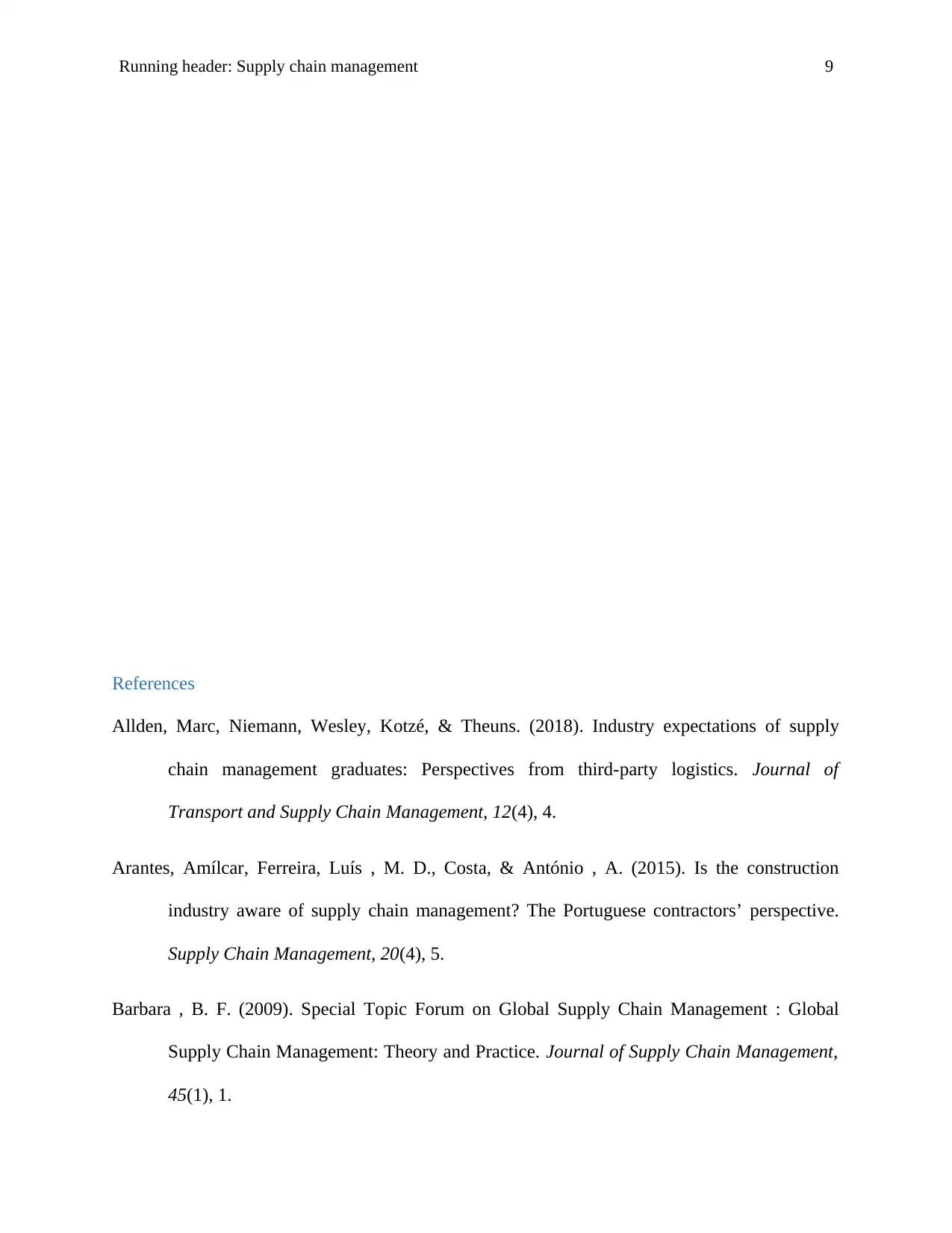
Running header: Supply chain management 9
References
Allden, Marc, Niemann, Wesley, Kotzé, & Theuns. (2018). Industry expectations of supply
chain management graduates: Perspectives from third-party logistics. Journal of
Transport and Supply Chain Management, 12(4), 4.
Arantes, Amílcar, Ferreira, Luís , M. D., Costa, & António , A. (2015). Is the construction
industry aware of supply chain management? The Portuguese contractors’ perspective.
Supply Chain Management, 20(4), 5.
Barbara , B. F. (2009). Special Topic Forum on Global Supply Chain Management : Global
Supply Chain Management: Theory and Practice. Journal of Supply Chain Management,
45(1), 1.
References
Allden, Marc, Niemann, Wesley, Kotzé, & Theuns. (2018). Industry expectations of supply
chain management graduates: Perspectives from third-party logistics. Journal of
Transport and Supply Chain Management, 12(4), 4.
Arantes, Amílcar, Ferreira, Luís , M. D., Costa, & António , A. (2015). Is the construction
industry aware of supply chain management? The Portuguese contractors’ perspective.
Supply Chain Management, 20(4), 5.
Barbara , B. F. (2009). Special Topic Forum on Global Supply Chain Management : Global
Supply Chain Management: Theory and Practice. Journal of Supply Chain Management,
45(1), 1.
⊘ This is a preview!⊘
Do you want full access?
Subscribe today to unlock all pages.

Trusted by 1+ million students worldwide
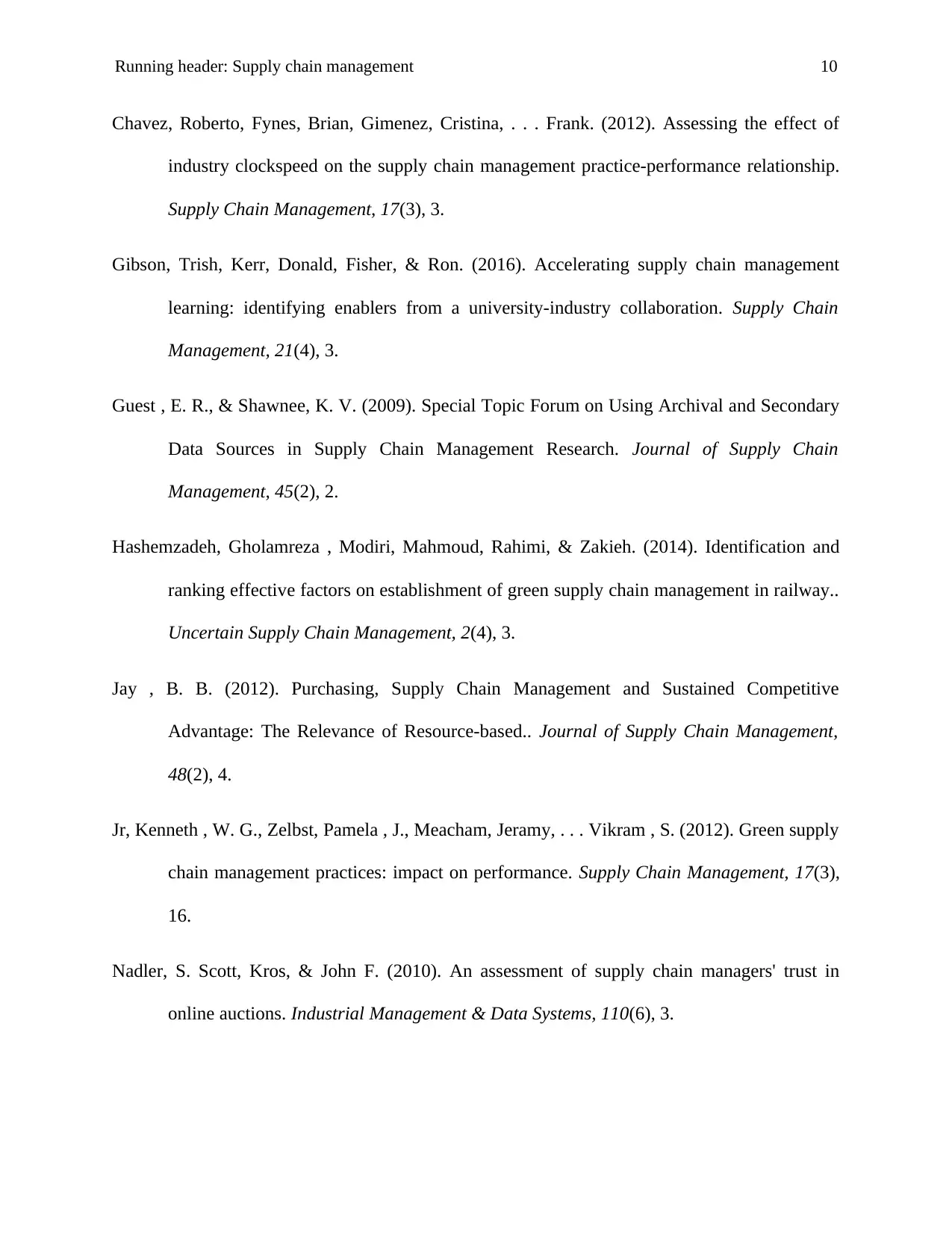
Running header: Supply chain management 10
Chavez, Roberto, Fynes, Brian, Gimenez, Cristina, . . . Frank. (2012). Assessing the effect of
industry clockspeed on the supply chain management practice‐performance relationship.
Supply Chain Management, 17(3), 3.
Gibson, Trish, Kerr, Donald, Fisher, & Ron. (2016). Accelerating supply chain management
learning: identifying enablers from a university-industry collaboration. Supply Chain
Management, 21(4), 3.
Guest , E. R., & Shawnee, K. V. (2009). Special Topic Forum on Using Archival and Secondary
Data Sources in Supply Chain Management Research. Journal of Supply Chain
Management, 45(2), 2.
Hashemzadeh, Gholamreza , Modiri, Mahmoud, Rahimi, & Zakieh. (2014). Identification and
ranking effective factors on establishment of green supply chain management in railway..
Uncertain Supply Chain Management, 2(4), 3.
Jay , B. B. (2012). Purchasing, Supply Chain Management and Sustained Competitive
Advantage: The Relevance of Resource-based.. Journal of Supply Chain Management,
48(2), 4.
Jr, Kenneth , W. G., Zelbst, Pamela , J., Meacham, Jeramy, . . . Vikram , S. (2012). Green supply
chain management practices: impact on performance. Supply Chain Management, 17(3),
16.
Nadler, S. Scott, Kros, & John F. (2010). An assessment of supply chain managers' trust in
online auctions. Industrial Management & Data Systems, 110(6), 3.
Chavez, Roberto, Fynes, Brian, Gimenez, Cristina, . . . Frank. (2012). Assessing the effect of
industry clockspeed on the supply chain management practice‐performance relationship.
Supply Chain Management, 17(3), 3.
Gibson, Trish, Kerr, Donald, Fisher, & Ron. (2016). Accelerating supply chain management
learning: identifying enablers from a university-industry collaboration. Supply Chain
Management, 21(4), 3.
Guest , E. R., & Shawnee, K. V. (2009). Special Topic Forum on Using Archival and Secondary
Data Sources in Supply Chain Management Research. Journal of Supply Chain
Management, 45(2), 2.
Hashemzadeh, Gholamreza , Modiri, Mahmoud, Rahimi, & Zakieh. (2014). Identification and
ranking effective factors on establishment of green supply chain management in railway..
Uncertain Supply Chain Management, 2(4), 3.
Jay , B. B. (2012). Purchasing, Supply Chain Management and Sustained Competitive
Advantage: The Relevance of Resource-based.. Journal of Supply Chain Management,
48(2), 4.
Jr, Kenneth , W. G., Zelbst, Pamela , J., Meacham, Jeramy, . . . Vikram , S. (2012). Green supply
chain management practices: impact on performance. Supply Chain Management, 17(3),
16.
Nadler, S. Scott, Kros, & John F. (2010). An assessment of supply chain managers' trust in
online auctions. Industrial Management & Data Systems, 110(6), 3.
Paraphrase This Document
Need a fresh take? Get an instant paraphrase of this document with our AI Paraphraser
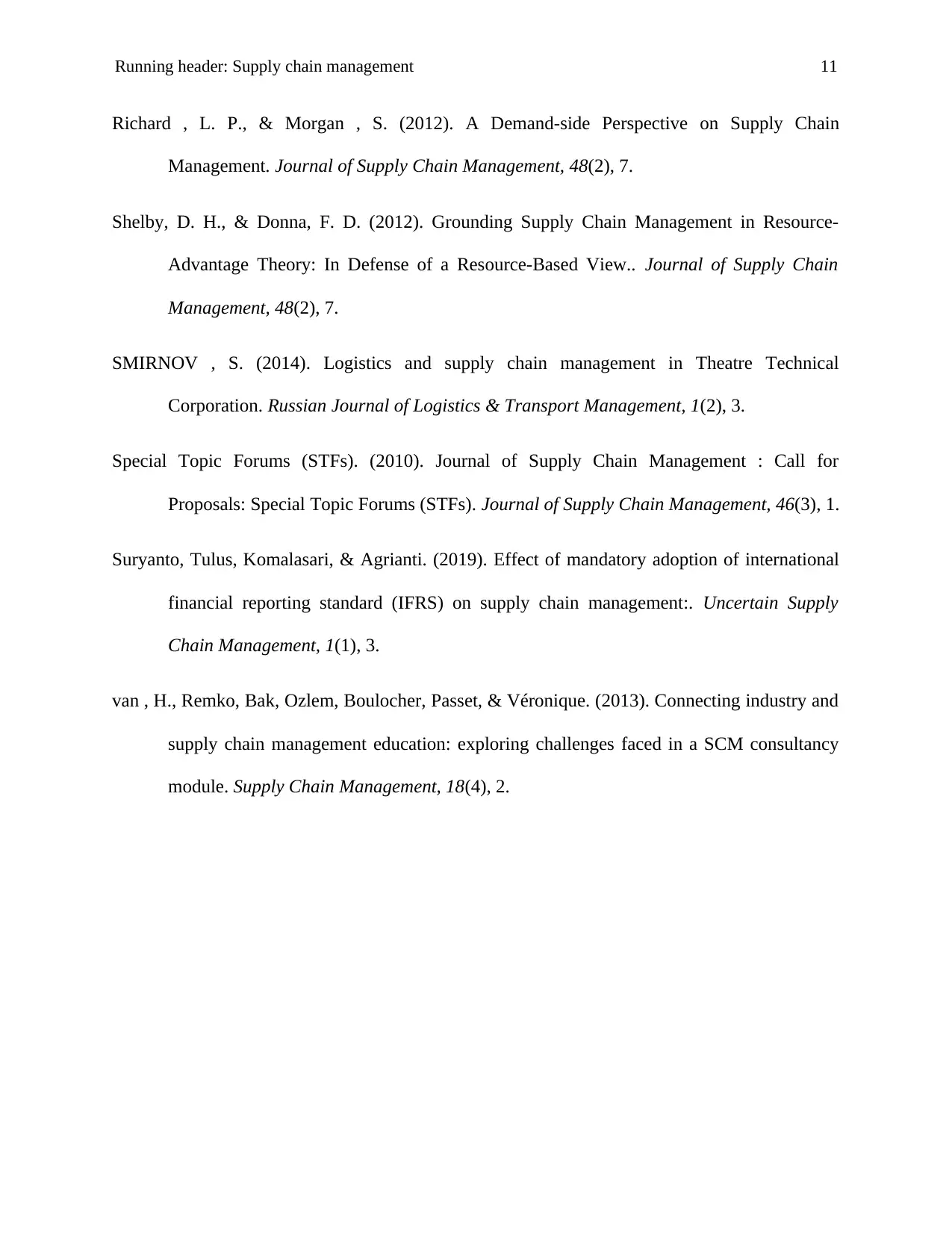
Running header: Supply chain management 11
Richard , L. P., & Morgan , S. (2012). A Demand-side Perspective on Supply Chain
Management. Journal of Supply Chain Management, 48(2), 7.
Shelby, D. H., & Donna, F. D. (2012). Grounding Supply Chain Management in Resource-
Advantage Theory: In Defense of a Resource-Based View.. Journal of Supply Chain
Management, 48(2), 7.
SMIRNOV , S. (2014). Logistics and supply chain management in Theatre Technical
Corporation. Russian Journal of Logistics & Transport Management, 1(2), 3.
Special Topic Forums (STFs). (2010). Journal of Supply Chain Management : Call for
Proposals: Special Topic Forums (STFs). Journal of Supply Chain Management, 46(3), 1.
Suryanto, Tulus, Komalasari, & Agrianti. (2019). Effect of mandatory adoption of international
financial reporting standard (IFRS) on supply chain management:. Uncertain Supply
Chain Management, 1(1), 3.
van , H., Remko, Bak, Ozlem, Boulocher, Passet, & Véronique. (2013). Connecting industry and
supply chain management education: exploring challenges faced in a SCM consultancy
module. Supply Chain Management, 18(4), 2.
Richard , L. P., & Morgan , S. (2012). A Demand-side Perspective on Supply Chain
Management. Journal of Supply Chain Management, 48(2), 7.
Shelby, D. H., & Donna, F. D. (2012). Grounding Supply Chain Management in Resource-
Advantage Theory: In Defense of a Resource-Based View.. Journal of Supply Chain
Management, 48(2), 7.
SMIRNOV , S. (2014). Logistics and supply chain management in Theatre Technical
Corporation. Russian Journal of Logistics & Transport Management, 1(2), 3.
Special Topic Forums (STFs). (2010). Journal of Supply Chain Management : Call for
Proposals: Special Topic Forums (STFs). Journal of Supply Chain Management, 46(3), 1.
Suryanto, Tulus, Komalasari, & Agrianti. (2019). Effect of mandatory adoption of international
financial reporting standard (IFRS) on supply chain management:. Uncertain Supply
Chain Management, 1(1), 3.
van , H., Remko, Bak, Ozlem, Boulocher, Passet, & Véronique. (2013). Connecting industry and
supply chain management education: exploring challenges faced in a SCM consultancy
module. Supply Chain Management, 18(4), 2.
1 out of 11
Your All-in-One AI-Powered Toolkit for Academic Success.
+13062052269
info@desklib.com
Available 24*7 on WhatsApp / Email
![[object Object]](/_next/static/media/star-bottom.7253800d.svg)
Unlock your academic potential
Copyright © 2020–2025 A2Z Services. All Rights Reserved. Developed and managed by ZUCOL.